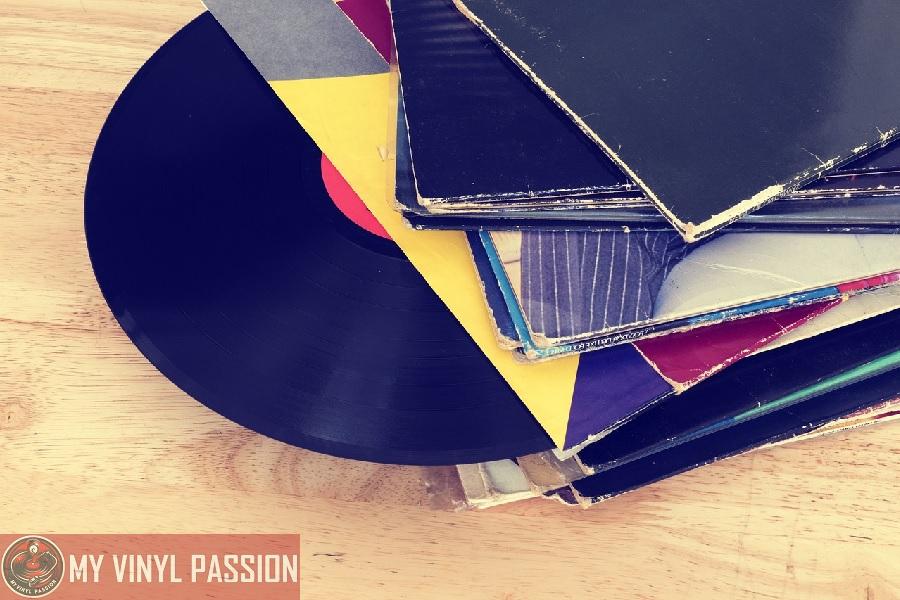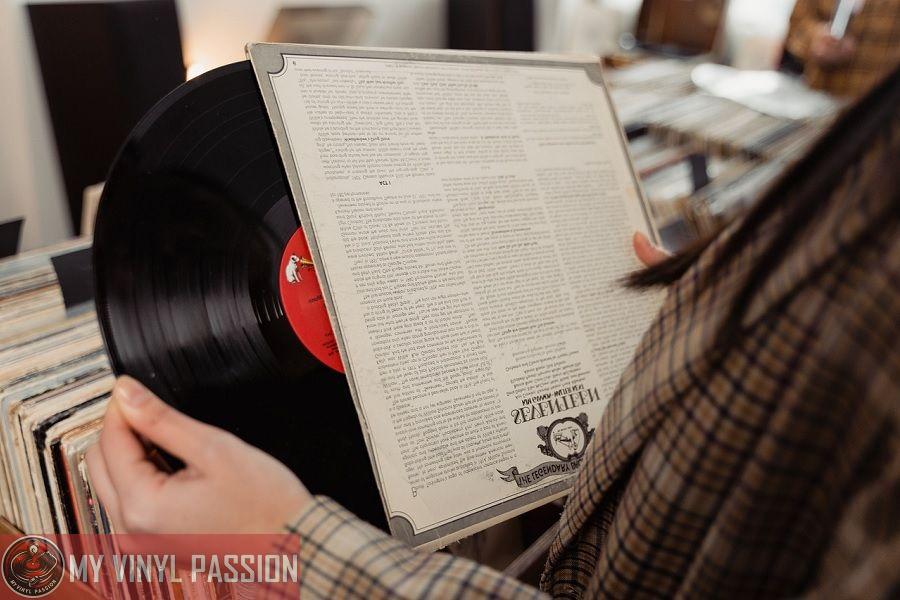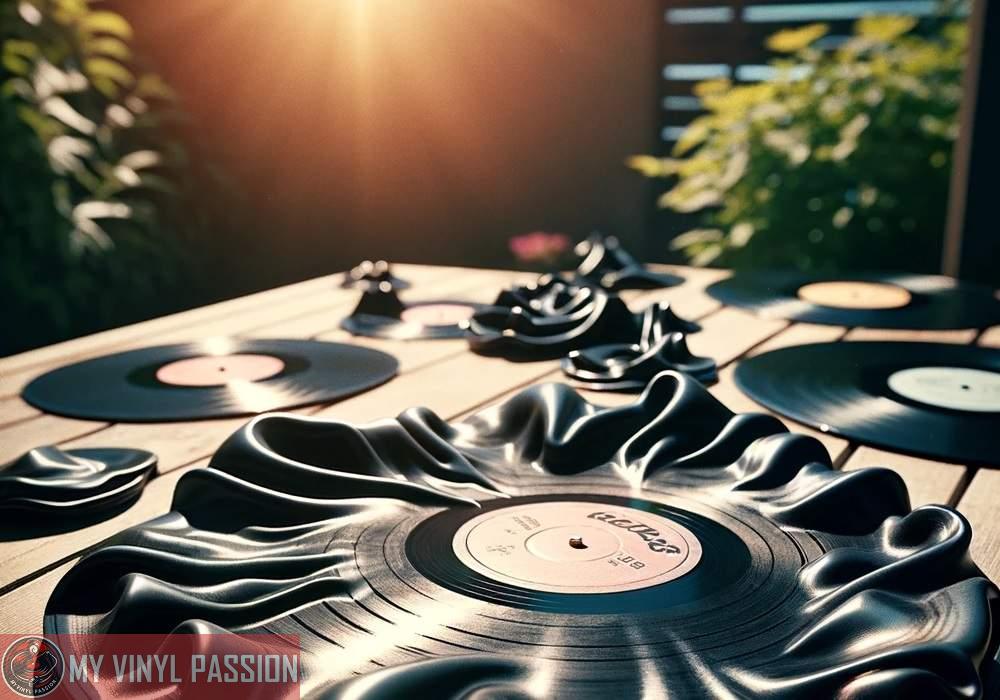Vinyl records have made a remarkable comeback in recent years, and if you’re a collector or just starting your collection, it’s crucial to properly store your records to maintain their quality and longevity.
Vinyl is a delicate material that requires the right balance of temperature and humidity to keep it from warping, cracking, or becoming damaged in any way.
Understanding the composition of vinyl records and the impact of environmental factors is essential to ensure the proper preservation of your collection.
The ideal storage temperature for vinyl records is between 65°F and 70°F (18°C and 21°C). This range helps maintain the structural integrity of your records, preventing them from warping or losing their shape.
In Summary
Maintain a storage temperature of 65°F to 70°F (18°C to 21°C) for your vinyl records.
Balance temperature with proper humidity levels to prevent damage.
Invest in storage solutions and protective accessories for long-term preservation.
Understanding Vinyl Composition
Vinyl records are made from a special type of plastic called polyvinyl chloride (PVC). PVC is a thermoplastic material, meaning it can be softened and molded when heated.
This ensures the grooves are accurately embedded during the manufacturing process, allowing for high-quality sound reproduction. However, the same property makes vinyl records sensitive to heat and temperature changes.
When exposed to heat, vinyl becomes soft and malleable, potentially warping the grooves and compromising sound quality. Conversely, if vinyl gets too cold, it can become brittle and prone to cracks or breaks.
To maintain the integrity of your collection, understanding how temperature affects vinyl records is essential.
The melting point of PVC is between 160℃ to 210℃ (320°F to 410°F), but it doesn’t have to reach these extreme temperatures to cause damage. Warping can occur at much lower temperatures, as low as 50℃ (122°F). To ensure the longevity of your collection, consider these optimal storage conditions:
- Temperature: Store your vinyl records in a stable environment, with temperatures between 18℃ to 21℃ (65°F to 70°F). This range helps maintain the structural composition of the vinyl while avoiding warping, brittleness, or melting.
- Humidity: Try to keep humidity levels between 45% to 50%. Higher humidity may cause mold growth or label damage, while lower humidity can increase static and brittleness.
Below is a summary of essential points for maintaining your vinyl records:
| Factor | Ideal Value | Reason |
|---|---|---|
| Temperature | 18℃ – 21℃ (65°F – 70°F) | Prevents warping, brittleness, or melting |
| Humidity | 45% – 50% | Avoids mold growth, label damage, or static accumulation |
By understanding the composition of vinyl and storing your records in optimal conditions, you’ll preserve their sound quality and physical appearance for years to come.
Ideal Storage Temperature
Temperature Fluctuations
To ensure the longevity of your vinyl records, it is essential to maintain a consistent temperature in their storage environment. Ideally, you should store your vinyl records at a steady temperature of 65 to 70°F (18 to 21°C).
Frequent temperature fluctuations can cause warping and damage to the grooves, which will ultimately affect the sound quality of your records.
It is important to also control the humidity level in the storage space. Aim for a relative humidity of 45 to 50%. Higher humidity levels may lead to mold growth and condensation on your records, while lower levels can cause the vinyl to become brittle and more susceptible to damage.
Extreme Temperatures
Avoid exposing your vinyl records to extreme temperatures, as this can cause irreversible damage. Exposure to high temperatures, such as those above 85°F (29°C), can cause the vinyl to soften and warp.
On the other hand, temperatures below 32°F (0°C) may result in the records becoming brittle and easily damaged.
Here are some tips to help protect your vinyl records from extreme temperatures:
- Store your records in a climate-controlled environment, away from heat sources such as radiators, direct sunlight, or vents.
- Avoid storing your records in basements or attics, as these areas are prone to temperature fluctuations and typically have little insulation from external conditions.
- If you must store your records in a room that experiences temperature fluctuations, consider using a dehumidifier and/or air purifier to help maintain a consistent environment.
By taking these precautionary measures, you will be able to preserve the quality of your vinyl records and enjoy their unique sound for years to come.
Importance of Relative Humidity
Moisture and Mold
Managing relative humidity is crucial for the preservation of your vinyl records. Excess moisture in the air can lead to the growth of mold and mildew, which may damage the record sleeves and the grooves of the records.
Ideally, you should store your vinyl collection in an environment with a humidity level between 45% and 50%.
To maintain a consistent humidity level, consider investing in a hygrometer to measure the amount of moisture in the air. Keeping a record of the humidity levels will enable you to take necessary measures for preventing mold growth.
Dehumidifier Usage
Using a dehumidifier can be an effective solution to control the humidity in your storage space, especially in damp or humid climates. A dehumidifier works by extracting moisture from the air, thus reducing the risks of mold and mildew development. Ensure the following when incorporating a dehumidifier in your storage space:
- Choose the appropriate size and capacity for the room where your vinyl records are stored.
- Regularly empty and clean the dehumidifier’s water container to avoid bacterial growth.
- Monitor the room’s humidity levels with a hygrometer and adjust the dehumidifier settings as needed.
In addition to using a dehumidifier, also maintain proper air circulation by keeping the door of the room ajar or using fans to allow air movement. This will help disperse moisture, further reducing the risk of mold and mildew growth.
Remember, maintaining the correct relative humidity is essential for the longevity of your vinyl collection. By controlling moisture and using the right tools, you can keep your records in optimum condition for many years to come.
Proper Handling and Storage Solutions
Handling Vinyl Records
It is essential to handle your vinyl records with care to maintain their longevity and sound quality. Always hold them by the edges and avoid touching the grooves; any dirt or oils from your hands can damage the vinyl.
Before playing a record, use a carbon fiber or anti-static brush to remove any dust or debris from the surface.
Storage Furniture
When it comes to storing your vinyl records, choosing the right storage furniture is crucial. An ideal solution is an upright storage system that can prevent warping and ensure their safekeeping.
The IKEA Kallax shelving unit is a popular option due to its versatility, affordability, and suitability to hold records. You can arrange and customize its shelves according to your collection’s size and needs.
For a more specialized option, consider investing in vinyl record storage cabinets designed explicitly for record storage. These cabinets typically have individual dividers that maintain an upright position for each record, further protecting them from damage.
However, storage cabinets can be more expensive than other options, so keep your budget in mind when making your decision.
Make sure to store your vinyl records in a cool, dry environment, away from direct sunlight, heat, and humidity. The ideal temperature for storing vinyl records ranges between 65 – 70°F (18 – 21°C), with a relative humidity of 45 – 50%.
When organizing your records, consider the following recommendations:
- Sort your collection alphabetically, by genre, or by artist to make it easier to locate specific records.
- Use plastic outer sleeves to protect the album covers and clear inner sleeves to guard the records themselves.
- Store records vertically, as stacking them horizontally can cause warping and other damage over time.
If you have an extensive collection, you may require additional overflow storage options. In this case, specialty storage boxes designed for vinyl records can be a useful, temporary solution until you can expand or upgrade your storage furniture.
By following these handling and storage guidelines, you can ensure the longevity and enjoyment of your vinyl records for years to come.
Avoiding Light and Heat Exposure
Sunlight Damage
It’s essential to protect your vinyl records from direct sunlight and ultraviolet light exposure. Prolonged sunlight exposure can cause warping and fading of the record’s artwork. To prevent this damage, follow these guidelines:
- Store your records in a cool, dark place away from windows
- Use opaque or thick, dark-colored record sleeves
- Rotate your collection frequently to avoid prolonged exposure to the same records
Proximity to Heat Sources
Exposure to heat and extreme temperature fluctuations can also damage your vinyl records. Keeping them in close contact with heat sources for extended periods can cause irreversible warping or melting.
Consider these tips to keep your records away from heat:
- Avoid placing your storage unit near radiators, vents, or heaters
- Keep records at least 3 feet away from electronic devices that emit heat, such as amplifiers
- Maintain a consistent room temperature between 60-70°F (15-21°C)
In summary, avoiding light and heat exposure for your vinyl records is crucial to preserve their condition and longevity. By implementing these practices, you can confidently maintain your collection’s sound quality and visual appeal.
Protective Accessories for Vinyl
Sleeves and Dividers
To keep your vinyl records in the best condition, it’s essential to use proper sleeves and dividers for storage. These accessories help prevent dust, static, and other potential damages.
- Inner Sleeves: These sleeves encase the vinyl record directly and protect it from dust, scratches, and static. Opt for anti-static or archival-quality plastic sleeves over traditional paper sleeves, as they provide better protection.
- Outer Sleeves: These sleeves provide another layer of protection for the record and its cover art. They are typically transparent, allowing for easy identification and display. Choose a high-quality, heavy-duty plastic sleeve for optimal protection.
- Dividers: To keep your records organized and accessible, use sturdy cardboard spacers as dividers. These help maintain a consistent spacing between records, reducing the risk of warping or other damage.
Outer and Inner Protection
Since not all sleeves and dividers are made equal, consider the following features when choosing the best options for your collection:
- Material: Opt for sleeves made from acid-free, anti-static materials to minimize record wear and tear. Avoid using PVC-based plastics, as these can deteriorate over time and potentially harm your vinyl.
- Thickness: Thicker sleeves provide better protection by acting as a more significant barrier between your records and their environment. Look for sleeves with a thickness between 3 to 5 mils for optimal results.
- Fit: The ideal sleeves and dividers should fit snugly around your records without being too tight or too loose. It’s crucial to avoid any unnecessary pressure on the grooves, which can cause damage over time.
By investing in the right protective accessories for your vinyl records, you can help ensure their longevity and maintain their pristine condition. Consider sleeves, dividers, and other protective elements to preserve your collection and enjoy it for years to come.
Organizing Your Vinyl Collection
Proper organization of your vinyl collection is crucial to preserving the quality and lifespan of your albums. Organized records are not only easier to navigate but also decrease the chance of accidental damage.
When sorting your collection, start by categorizing your albums according to your personal preferences. You can organize your records alphabetically, by artist, genre, or even by release date.
To further simplify the process, use dividers to separate your sections. Vinyl record dividers can be found in various materials, such as plastic, wood, or metal, providing both functionality and a touch of style to your collection.
It is important to consider the size of your collection when selecting a storage method. If you have a small vinyl collection, a tabletop record holder or a storage box might suffice.
For larger collections, consider investing in a dedicated shelving unit with ample space to store your records vertically. Make sure there is enough space between records to prevent overcrowding and reduce the risk of warping or scratching.
Keep in mind the location of your collection storage. Ideally, it should be a cool, dry area, away from direct sunlight, heat sources, and dampness. Prolonged exposure to excessive heat or humidity can damage your records.
Ensure your vinyl collection storage is neither too close to a radiator nor somewhere with fluctuating temperatures, such as a garage or attic.
In summary:
- Categorize your albums based on your preferences.
- Use dividers to separate sections.
- Choose an appropriate storage method considering the size of your collection.
- Store your records vertically with enough space between them.
- Opt for a cool, dry location away from heat sources and dampness.
By following these tips, you can successfully organize your vinyl collection and maintain the quality of your cherished albums for years to come.
Long-Term Preservation Strategies
Avoid Stacking and Pressure
The way you store your vinyl records plays a crucial role in preventing damage and warping. To ensure the longevity of your collection, avoid stacking records on top of each other.
This method exerts excessive weight and pressure on the lower records, potentially causing warping and damage to both the vinyl and the cover. Instead, store your vinyl records vertically, with each album next to one-another, similar to books on a shelf.
This approach helps maintain their shape and prevent warping.
Regular Cleaning and Maintenance
A well-maintained collection of vinyl records not only sounds better but also lasts longer. Incorporate a regular cleaning routine to protect your records from damage and extend their lifespan. Here are some tips for effective cleaning and maintenance:
- Anti-static brush: Using an anti-static brush just before playing a record reduces the buildup of static electricity and prevents dust from clinging to the vinyl surface.
- Microfiber cloth: Gently wipe the records and their covers with a clean microfiber cloth to remove any dust or debris.
- Cleaning brush: Invest in a cleaning brush specifically designed for vinyl records, as it can easily reach the grooves and remove dirt particles.
- Cleaning solution: Use a cleaning solution specifically made for vinyl records. Mix the solution with distilled water in a ratio recommended by the manufacturer, and use it in combination with the cleaning brush for a thorough cleaning.
By incorporating these long-term preservation strategies, you will ensure your collection of vinyl records remains in top-notch condition for many years to come.
Frequently Asked Questions
What temperature range is ideal for preserving vinyl records?
To best preserve your vinyl records, store them in a consistent temperature range of 65 to 70°F (18 to 21°C). Deviation from this temperature range could cause warping or damage to the records.
How does high heat affect the condition of vinyl records?
High heat causes vinyl to become soft and pliable, leading to warping and distortion of the grooves. This can result in poor sound quality, skipping, and even permanent damage to your records.
Is it safe to store vinyl records in a garage with fluctuating temperatures?
Storing vinyl records in a garage with fluctuating temperatures is not recommended, as the constant changes in temperature can cause the records to warp and become brittle. It is best to store your records in a climate-controlled environment.
What measures should be taken to protect vinyl records from heat damage?
Keep your vinyl records away from direct sunlight and heat sources, such as radiators or vents. Store your records in a cool, dark place with stable humidity. If you are unable to maintain a consistent temperature environment, consider investing in a climate-controlled storage unit.
Can humidity levels impact the quality of vinyl record storage?
Yes, high humidity can lead to mold and mildew growth on your vinyl records. It is essential to maintain a humidity level of 45-50% to prevent any damage to your collection. In areas with high humidity, consider using a dehumidifier to maintain optimal conditions.
What types of storage furniture are recommended for maintaining the optimal condition of vinyl records?
Choose storage furniture designed specifically for vinyl records, with sturdy, vertical shelving to ensure proper weight distribution. Make sure the storage unit is located away from direct sunlight, heat sources, and areas of high humidity. Utilize acid-free, protective record sleeves to further protect your vinyl records from potential damage.





